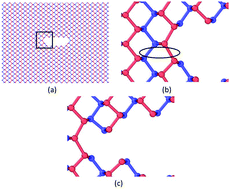Fracture patterns and the energy release rate of phosphorene†
Abstract
Phosphorene, also known as monolayer black phosphorus, has been enjoying popularity in electronic devices due to its superior electrical properties. However, it's relatively low Young's modulus, low fracture strength and susceptibility to structural failure have limited its application in mechanical devices. Therefore, in order to design more mechanically reliable devices that utilize phosphorene, it is necessary to explore the fracture patterns and energy release rate of phosphorene. In this study, molecular dynamics simulations are performed to investigate phosphorene's fracture mechanism. The results indicate that fracture under uniaxial tension along the armchair direction is attributed to a break in the interlayer bond angles, while failure in the zigzag direction is triggered by the break in both intra-layer angles and bonds. Furthermore, we developed a modified Griffith criterion to analyze the energy release rate of phosphorene and its dependence on the strain rates and orientations of cracks. Simulation results indicate that phosphorene's energy release rate remains almost unchanged in the armchair direction while it fluctuates intensively in the zigzag direction. Additionally, the strain rate was found to play a negligible role in the energy release rate. The geometrical factor α in the Griffith's criterion is almost constant when the crack orientation is smaller than 45 degree, regardless of the crack orientation and loading direction. Overall, these findings provide helpful insights into the mechanical properties and failure behavior of phosphorene.


 Please wait while we load your content...
Please wait while we load your content...